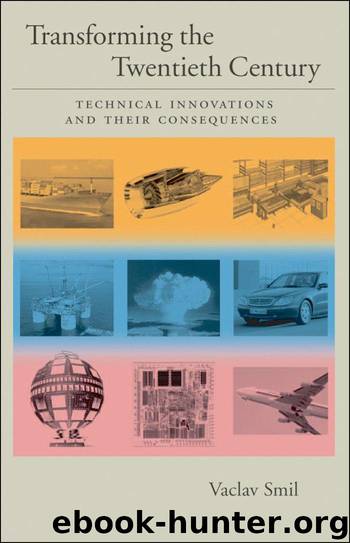Transforming the Twentieth Century: Technical Innovations and Their Consequences: Technical Innovations and Their Consequences v. 2 by Smil Vaclav

Author:Smil, Vaclav [Smil, Vaclav]
Language: eng
Format: azw3
Publisher: Oxford University Press
Published: 2006-03-20T05:00:00+00:00
FIGURE 4.17. The first two drawings of George Devol’s patent (U.S. Patent 2,988,237 granted in 1961, filed in 1954) for programmed article transfer, the automatic operation of machinery for materials handling. Control unit (26) contains the program drum (40) to direct the transfer apparatus (10), whose head (10a) contains a hydraulic actuator (42) and a jaw (44) to handle articles (20) on pallets (16). Available from the U.S. Patent Office.
The present innovation makes available for the first time a more or less general purpose machine that has universal application to a vast diversity of applications where cyclic control is to be desired; and in this aspect, the invention accomplishes many important results. It eliminates the high cost of specially designed cam controlled machines; it makes an automatically operating machine available where previously it may not have been economical to make such a machine with cam-controlled, specially designed parts; it makes possible the volume manufacture of universal automatic machines that are readily adaptable to a wide range of diversified applications; it makes possible the quick change-over of a machine adapted to any particular assignment so that it will perform new assignments, as required from time to time. (Devol 1961:1)
By the time the patent was granted, in June 1961, the invention moved from a concept to a working machine. In 1956 Devol met at a party Joseph F. Engelberger, an aerospace engineer, and they decided to set up the world’s first robot company, Unimation (contracted from universal automation). They built the first prototype transfer machine in 1958, and in 1961 their first industrial robot was sent from their Danbury, Connecticut, factory to a GM plant in Trenton, New Jersey, to be used for lifting and stacking hot metal parts made by a die-casting machine. Commands for the operation of its 1.8 t motorized arm were stored on a magnetic drum. Unimation did not make any profit until 1975, but both men continued to advance the process of industrial automation: Devol by working on machine vision (including the now ubiquitous bar coding) and Engelberger by designing automatic assembly systems and promoting robots for service tasks (Engelberger 1989).
While the first Unimation robot was readied for industrial deployment, the American Machine and Foundry offered its first Versatran, a cylindrical robot designed by Harry Johnson and Veljko Milenkovic, in 1960. In 1969 the Stanford Arm, designed by Victor Scheinman, was the first computer-controlled and electrically powered kinematic configuration. In 1973 Cincinnati’s Milacron offered the world’s first minicomputer-operated industrial robot designed by Richard Hohn (Scott 1984). In May of 1978 Unimation brought out its PUMA (Programmable Universal Machine for Assembly) designed to duplicate the functions of the human arm and hand. But despite these American advances, Japan companies became the world’s leaders in robotics. In 1967 the first Versatran was imported to Japan, and a year later Kawasaki Heavy Industries began to produce licensed Unimation machines. Subsequent progress was very rapid. By 1980 Japan had 47,000 robots, compared to fewer than 6,000 in Germany and 3,200 in the United States.
Download
This site does not store any files on its server. We only index and link to content provided by other sites. Please contact the content providers to delete copyright contents if any and email us, we'll remove relevant links or contents immediately.
| Africa | Americas |
| Arctic & Antarctica | Asia |
| Australia & Oceania | Europe |
| Middle East | Russia |
| United States | World |
| Ancient Civilizations | Military |
| Historical Study & Educational Resources |
Cecilia; Or, Memoirs of an Heiress — Volume 1 by Fanny Burney(32503)
Cecilia; Or, Memoirs of an Heiress — Volume 2 by Fanny Burney(31913)
Cecilia; Or, Memoirs of an Heiress — Volume 3 by Fanny Burney(31898)
The Secret History by Donna Tartt(18951)
Sapiens: A Brief History of Humankind by Yuval Noah Harari(14322)
Leonardo da Vinci by Walter Isaacson(13238)
The Radium Girls by Kate Moore(11977)
Sapiens by Yuval Noah Harari(5325)
How Democracies Die by Steven Levitsky & Daniel Ziblatt(5175)
The Wind in My Hair by Masih Alinejad(5060)
Homo Deus: A Brief History of Tomorrow by Yuval Noah Harari(4873)
Endurance: Shackleton's Incredible Voyage by Alfred Lansing(4722)
Man's Search for Meaning by Viktor Frankl(4505)
The Silk Roads by Peter Frankopan(4492)
Millionaire: The Philanderer, Gambler, and Duelist Who Invented Modern Finance by Janet Gleeson(4425)
The Rape of Nanking by Iris Chang(4169)
Joan of Arc by Mary Gordon(4057)
The Motorcycle Diaries by Ernesto Che Guevara(4054)
Hitler in Los Angeles by Steven J. Ross(3925)
